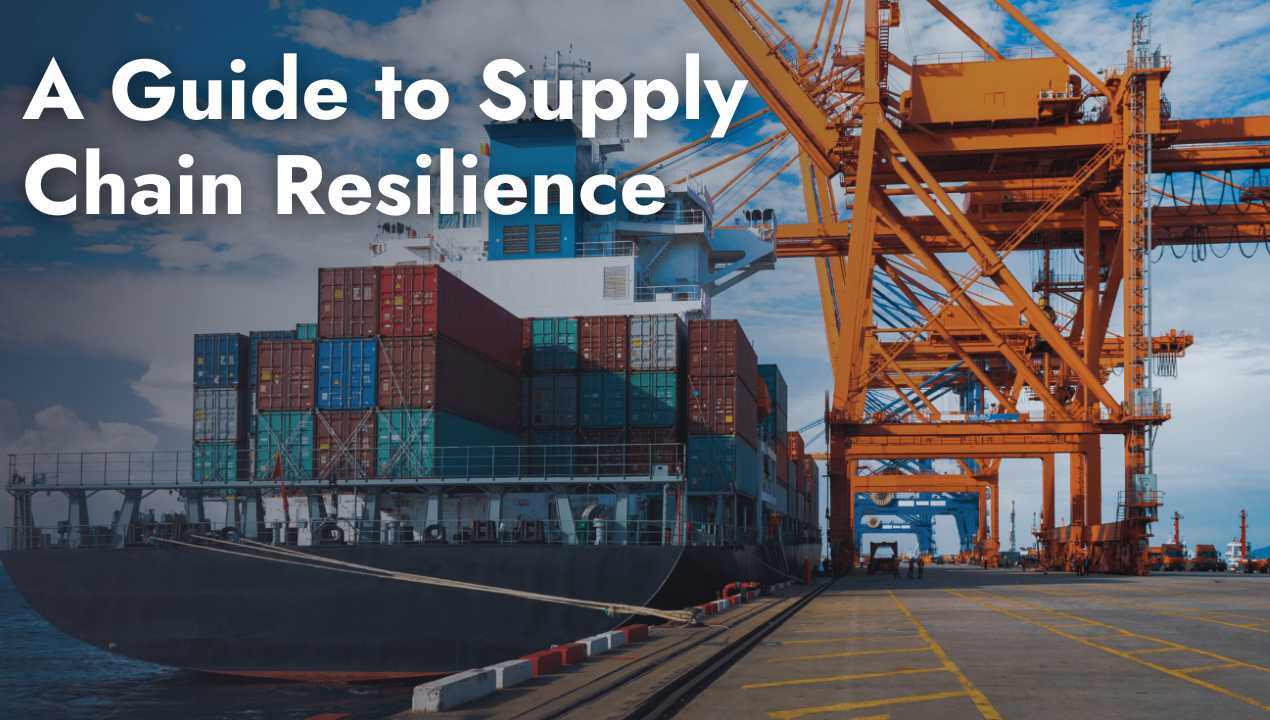Share this
15 Supply Chain KPIs Every Ecommerce Business Should Track
by Rin Mosher on Apr. 23, 2024

Supply chain management in ecommerce involves many moving parts—each presenting a wide range of variables that can impact the efficiency and, in turn, the success of your business. The best way to optimize supply chain performance is by tracking important supply chain KPIs. From supplier lead time to order accuracy rate, ecommerce businesses can use these metrics to identify areas for improvement and, ultimately, boost their performance.
In this article, we explore which supply chain KPIs are most relevant to ecommerce businesses, how to measure them, and how you can use them to optimize your business.
What Are Supply Chain KPIs?
Supply chain KPIs, or Key Performance Indicators, are metrics used to measure the performance and success of a company's supply chain operations. These metrics are used to track and evaluate various aspects of the supply chain, from inventory management and transportation efficiency to supplier relationships and customer satisfaction.
KPIs provide valuable insights into the performance of a company's supply chain, helping to identify areas to improve and optimize. They also serve as benchmarks to measure progress against goals and industry competitors.
15 Supply Chain KPIs Worth Tracking
If you aren't sure where to start with KPIs for supply chain management and analysis, consider the following list of metrics. These have all been hand-picked to address key areas of concern for ecommerce businesses: customer service and order management, inventory management, finances, and supplier and freight management.
Supply Chain KPIs for Order Management and Customer Service
1. Order Accuracy Rate
Order accuracy indicates what percentage of a business' outgoing orders are fulfilled without any errors or mistakes. This supply chain KPI is directly tied to customer satisfaction and trust. The higher an order accuracy rate is, the better a business is at doing its job of correctly fulfilling and shipping orders to customers.
Conversely, poor order accuracy rates indicate logistical inefficiencies with the potential to have downstream implications on buyers' experience. If a customer is frequently receiving incorrect orders, they’ll eventually stop ordering from that business.
Order accuracy rate formula:
Order Accuracy Rate = (Total Number of Orders Fulfilled Accurately ÷ Total Number of Orders Fulfilled) x 100
Order accuracy rate is affected by many factors, with common issues that can negatively impact this KPI including the shipment of wrong items, incorrect quantities, or missing items from orders.
2. On-Time Delivery Rate
The on-time delivery rate defines the percentage of orders a seller successfully delivers to its customers within a defined time frame. Similarly to order accuracy rate, this metric has a significant influence on how buyers perceive a brand and can impact customer satisfaction, loyalty, and retention.
The challenge for ecommerce sellers is that on-time delivery is hard to control. Achieving a high on-time delivery rate comes down to a fulfillment system's effectiveness and ability to adapt to changing conditions. This is why it’s critical to choose an ecommerce fulfillment services partner that’s not only capable of meeting unforeseen spikes in demand but also scaling with your business.
Use this formula to calculate the on-time delivery rate:
On-Time Delivery Rate = (Number of Successful Deliveries/Number of Total Deliveries) x 100
3. Order Fill Rate
The order fill rate measures how consistently a business can fulfill orders using available inventory. This is in contrast to cases where there is not enough stock to fulfill an order in its entirety, leading to backorders or split and delayed shipments.
Maintaining a high order fill rate is crucial to ensuring satisfaction and repeat purchases. A low order fill rate can indicate issues with inventory management, supplier reliability, or forecasting accuracy. The consequences of these issues - including stockouts and lost sales - can all be mitigated by staying on top of inventory management.
The reorder point formula is one way to streamline inventory management. This equation takes factors like lead time and safety stock to determine when inventory should be replenished. Knowing that information makes mitigating inventory shortages and any negative effects on your order fill rate easier.
Order fill rate formula:
Order Fill Rate: (1 – [(Total Items Ordered – Total Items Shipped) / Total Items Ordered]) x 100
4. Customer Order Cycle Time
Customer order cycle time is a representation of how long, on average, buyers wait from the moment they place an order to when they receive it. The formula uses the order and delivery date data from every order placed within a defined period of time to calculate the average cycle length.
Customer order cycle time formula:
Average Customer Order Cycle Time = (Sum of (Delivery Date - Order Date)) / Total Number of Orders Shipped
Waiting to receive an order is one of the major pain points customers face when shopping online. Short customer order cycle times indicate that a business is consistently shipping orders out in a timely manner, avoiding that issue. However, longer order cycle times suggest an inefficient fulfillment process that might be suffering from various mistakes and delays – and potentially inconveniencing customers.
5. Return Rate
The return rate is one of the most telling supply chain KPIs in ecommerce, measuring the frequency at which items are returned by customers after purchase. It is calculated by dividing the number of returned items by the total number of items sold in a specific time period.
Return rate formula:
Return Rate = (Number of Items Returned / Number of Items Sold) x 100
Return rates vary drastically across the ecommerce space. A number of factors can influence this supply chain KPI, from the type of products sold to the terms outlined in a business' returns policy.
For example, a fashion retailer may have a higher return rate due to the unpredictable fit of clothing items, while a bookstore may have a lower return rate as books are generally easier to depict online accurately.
6. Perfect Order Rate
Perfect order rate is similar to the order accuracy rate, as it also assesses the overall effectiveness of the fulfillment process. The two supply chain KPIs differ in that the perfect order rate can encompass a broader range of criteria beyond error-free shipments and usually includes on-time delivery, orders shipped complete, orders shipped undamaged, and correct documentation.
Perfect order rate formula:
Perfect Order Rate = (Number of Orders That Meet Criteria / Total Number of Orders) x 100
The defining inputs of perfect order rate may differ from circumstance to circumstance. In any case, it should always consider every measure of 'order success' that a business values - whether that's completion, timeliness, accuracy, or any other factor.
Supply Chain KPIs for Inventory Management
7. Inventory Accuracy
Inventory accuracy measures the ratio of stock physically counted in inventory against what is recorded in a company's inventory system. Any discrepancies between actual and recorded levels represent a problem for both the warehouse and the overall supply chain.
Inventory accuracy formula:
Inventory Accuracy = (Counted Units / Units on Record) x 100
Expressed as a percentage, inventory accuracy should be as close to 100 as possible. A high level of inventory accuracy indicates that the warehouse is consistently managing and counting its inventory well. Regular cycle counting can help identify and correct small-scale variances before they become bigger issues.
8. Days Sales of Inventory
Days Sales of Inventory (DSI) is a supply chain KPI that informs decision-making by measuring inventory management efficiency. It calculates how many days it takes for a business to sell its entire inventory stock.
Days sales of inventory formula:
Days Sales of Inventory = (Average Inventory / Cost of Goods Sold) x 365
This KPI helps businesses understand their inventory turnover rate and identify potential issues in their supply chain. A high DSI value could indicate slow-moving products, overstocking, or poor forecasting. On the other hand, a low number could signal a strong demand for products and efficient inventory management.
9. Inventory Turnover Ratio
The inventory turnover ratio measures the speed at which stock is sold and replaced in a warehouse. A high inventory turnover ratio signifies that stock is being sold quickly, which is generally positive as it indicates strong sales. However, it is important to consider the industry average and seasonality when analyzing this metric to ensure an accurate interpretation.
Conversely, a low inventory turnover ratio may suggest slower sales, leading to overstocking, increased holding costs, and potentially obsolete inventory. And a very high inventory turnover isn’t always a good thing – it can lead to stockouts and lost sales if not managed properly, especially if demand spikes unexpectedly.
Inventory turnover ratio formula:
Inventory Turnover Ratio = (Cost of Goods Sold / Average Inventory)
You can download our free inventory management calculator for quick answers on your ending inventory, inventory turnover, and reorder point so you can easily track your supply chain KPIs.
Download Our Free Inventory Management Calculator
Financial Supply Chain KPIs
10. Cast-to-Cash Cycle Time
Cash-to-Cash Cycle Time provides a comprehensive view of the time it takes a company to convert its investments in inventory and other operating costs into cash from sales, known as the Cash Conversion Cycle (CCC). This metric consolidates three key supply chain KPIs—Days Sales Inventory (DSI), Days Sales Outstanding (DSO), and Days Payable Outstanding (DPO)—into one benchmark.
- DSO tracks the average time a business takes to collect payments for sales made on credit.
- DPO measures how long it takes a company to pay its vendors.
- DSI (also known as Days Inventory Outstanding) assesses the average time a company holds inventory before selling it.
Shorter Cash-to-Cash Cycle Times indicate more efficient processes, suggesting that a company quickly turns its inventory and receivables into cash. Conversely, longer cycles may highlight inefficiencies or redundancies in the management of inventory and receivables.
Cash-to-cash cycle time formula:
Cash-to-Cash Cycle Time = Days Sales of Inventory + Days Sales Outstanding − Days Payable Outstanding
11. Gross Margin Return On Investment
Gross Margin Return On Investment (GMROI) is a supply chain KPI used to evaluate the profitability of an ecommerce business. An inventory-focused version of Return On Investment (ROI), this metric calculates the amount of gross profit every dollar spent on inventory creates.
GMROI formula:
GMROI = (Gross Margin / Average Inventory Cost)
This KPI helps businesses understand how well their investments in inventory are performing and whether they are generating enough revenue to cover their costs. A high GMROI indicates that the business is generating a good return on every dollar invested in inventory, implying effective pricing strategies and inventory management. A low GMROI suggests that the inventory is not generating sufficient profit, which could be due to issues like overstocking, underpricing, or poor sales performance.
12. Cost Per Order
Decision-makers in the ecommerce space reference Cost Per Order to understand the cost-effectiveness of their fulfillment process. The CPO formula reflects how much a business spends to fulfill and ship customer purchases and can be helpful when planning everything from product retail prices to sales budgets.
Cost per order formula:
Cost Per Order = (Total Shipping Costs + Total Fulfillment Costs) / Number of Orders Shipped
It’s important to recognize that ‘Total Fulfillment Costs’ can be extensive. When using the cost per order formula, you’ll need to remember to include every expense associated with the fulfillment process, including picking and packing fees, packaging costs, storage, and more.
Cost per order is ultimately determined by the solutions and systems a company relies on for fulfillment. Third-Party Logistics (3PL) providers use the very best of each to keep unnecessary expenses to a minimum. The cost of partnering with a reputable service provider is often more than worthwhile considering the savings in CPO it has down the road.
Supply Chain KPIs for Supplier and Freight Management
13. Supplier Lead Time
Supplier lead time refers to the amount of time it takes a supplier to deliver goods after they're ordered. It's preferable to keep supplier lead times as short as possible, but this can vary depending on the products being ordered and the location of the supplier.
Supplier lead time formula:
Supplier Lead Time = (Date Goods Received - Date Order Placed)
Shorter supplier lead times enable faster inventory turnover, reduce the risk of stockouts, and decrease the need for large inventory holdings, thereby saving on storage costs. For ecommerce businesses working with multiple suppliers, including manufacturers and wholesalers, lead time can vary significantly based on the product type and the supplier’s location. This formula allows you to compare lead times between suppliers and seek out new or renegotiated contracts for cases in which the wait is too long.
14. Freight Cost Per Unit
Freight Cost Per Unit (CPU) is a supply chain KPI that measures the average cost to ship each individual unit of a product via freight truck. Shipping is a major element of supply chain costs, and on the large scale of freight shipping, even small changes in CPU can substantially impact a business' bottom line.
Freight cost per unit formula:
Freight Cost Per Unit = (Total Freight Costs / Number of Units Shipped)
Freight cost per unit can vary depending on whether shipping carriers use a dimensional weight-based pricing system or an actual weight-based system, the distance and mode of transportation used, and National Motor Freight Classification (NMFC) codes, which generally assign higher shipping fees to denser categories of product.
By tracking this KPI, businesses can analyze trends and fluctuations in shipping costs and implement strategies to minimize these expenses, such as negotiating better rates with carriers, optimizing shipment sizes, or choosing more cost-effective shipping methods. A 3PL with freight services can do all of these things on your behalf to keep your freight cost per unit low.
15. Freight Bill Accuracy
Following the importance of monitoring Freight Cost Per Unit, Freight Bill Accuracy is a metric that helps ensure these costs reflect actual contractual obligations. This KPI measures the accuracy of freight bills, including proper charges that align with agreed terms and the correct classification of items, weights, and dimensions.
Freight bill accuracy formula:
Freight Bill Accuracy = (Number of Accurate Freight Bills / Total Number of Freight Bills Issued)
Maintaining high freight bill accuracy helps prevent overcharges and resolve disputes with carriers to avoid unnecessary costs and delays. Errors in freight billing can significantly disrupt financial management and affect operational efficiency.
Partnering with a trustworthy 3PL provider that has its own freight forwarding services can alleviate the burden of conducting freight billing audits yourself. This strategic partnership can enhance the accuracy, predictability, and transparency of logistics spending while freeing up your resources for other critical operations.
How to Effectively Manage and Track Supply Chain KPIs
There are countless supply chain KPIs that can be used to gain valuable insight into a company's operational health, efficiency, and bottom line. It can be difficult for ecommerce businesses to track and analyze them all in a way that provides actionable information to drive strategic decisions. Partnering with a fulfillment service provider is often the most efficient way to manage and track supply chain KPIs effectively.
Partnering with a top-rated 3PL like Shipfusion means not having to worry about tracking every KPI to optimize your supply chain – because we can do it for you. From our triple-check system that guarantees a 99.9% order accuracy rate to our fulfillment software that automatically optimizes packaging specifications to keep shipping costs as low as possible, we ensure that your order fulfillment process is as optimized as possible so you can focus more on scaling your business. Contact us today to learn more about Shipfusion’s seamless fulfillment services.
Share this
You May Also Like
These Related Articles

A Guide to Supply Chain Resilience In Ecommerce

Inventory Visibility & Supply Chain Performance

How to Utilize Supply Chain Analytics
- April 2025 (18)
- March 2025 (26)
- February 2025 (26)
- January 2025 (37)
- December 2024 (16)
- November 2024 (23)
- October 2024 (22)
- September 2024 (27)
- August 2024 (9)
- July 2024 (8)
- June 2024 (5)
- May 2024 (8)
- April 2024 (8)
- March 2024 (6)
- February 2024 (6)
- January 2024 (5)
- December 2023 (3)
- November 2023 (3)
- October 2023 (5)
- September 2023 (4)
- August 2023 (2)
- July 2023 (1)
- June 2023 (4)
- March 2023 (2)
- October 2022 (1)
- September 2022 (5)
- August 2022 (4)
- July 2022 (7)
- June 2022 (4)
- May 2022 (4)
- April 2022 (6)
- March 2022 (2)
- February 2022 (1)
- January 2022 (3)
- December 2021 (2)
- November 2021 (4)
- October 2021 (2)
- September 2021 (5)
- August 2021 (4)
- July 2021 (4)
- June 2021 (3)
- May 2021 (2)
- April 2021 (3)
- March 2021 (3)
- February 2021 (3)
- January 2021 (2)
- December 2020 (4)
- November 2020 (2)
- October 2020 (4)
- September 2020 (2)
- July 2020 (5)
- June 2020 (4)
- May 2020 (2)
- April 2020 (2)
- March 2020 (4)
- February 2020 (1)
- December 2019 (1)
- May 2018 (1)
- March 2018 (2)
- February 2018 (3)
- January 2018 (3)
- November 2017 (3)
- July 2017 (4)
- March 2017 (3)
- February 2017 (5)
- January 2017 (3)
- December 2016 (4)
- November 2016 (6)
- October 2016 (6)
- October 2015 (1)
- September 2015 (1)
- June 2015 (3)
- May 2015 (3)
- August 2014 (1)
- July 2014 (1)
- March 2014 (1)
- February 2014 (1)